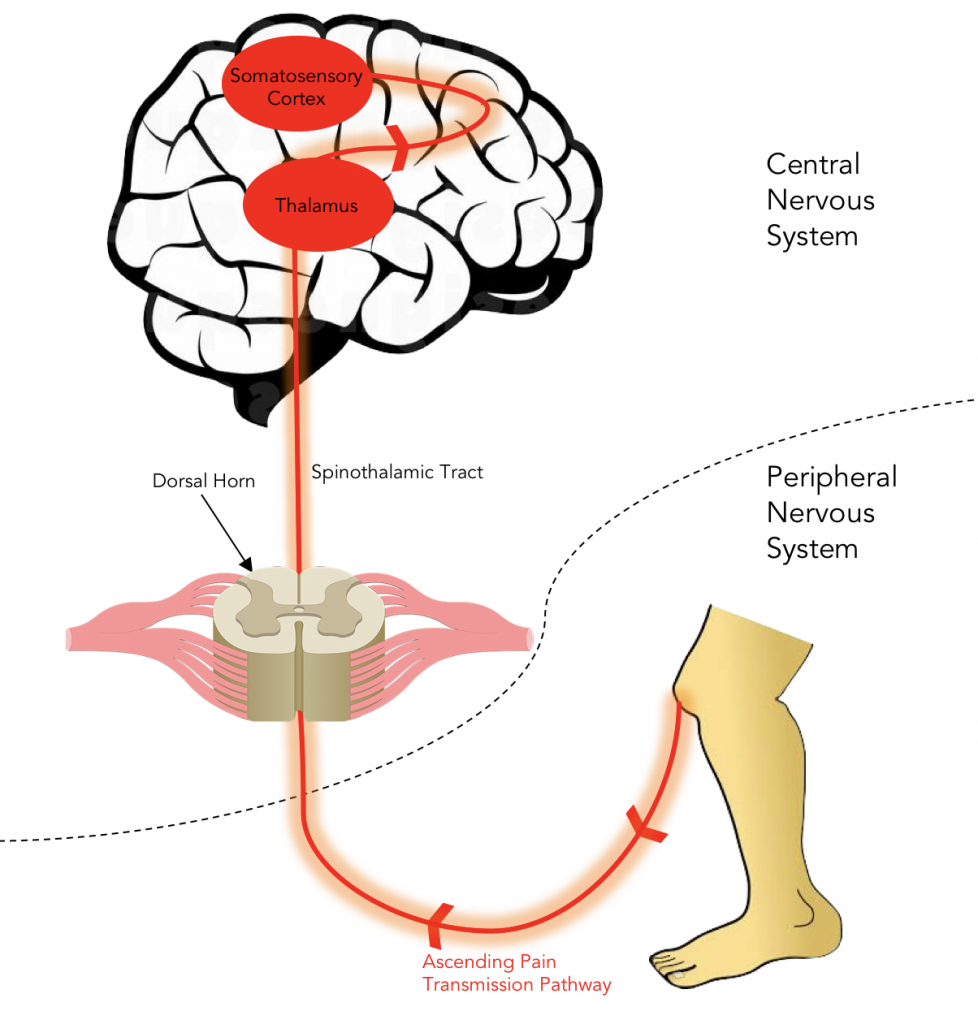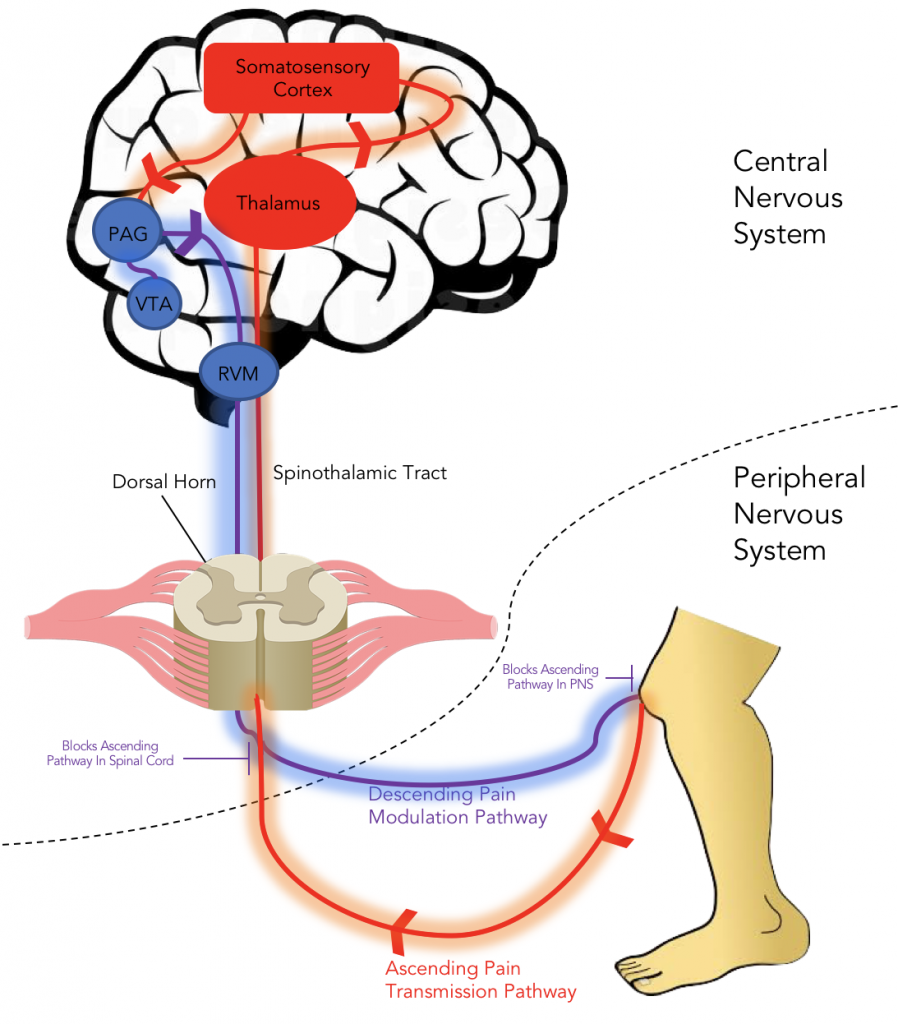Pain Transmission Pathway

Ascending pain pathway: All opioids, regardless of the initial receptor they bind to, utilize a similar pathway in order to inhibit pain signals. The process begins when pain sensory neurons, called nociceptors, detect a potentially damaging stimulus. These neurons send this signal as an action potential to other neurons using the excitatory neurotransmitters glutamate, which depolarizes the cell, and substance p, which promotes inflammation and pain (11). Once the signal reaches the base of dorsal horn, a column in the spinal cord that relays sensory information, it is then sent up though a network of neurons called the spinothalamic tract that delivers sensory signals from the spinal cord to the somatosensory cortex which perceives pain (12). This process, from signal detection and transmission by the peripheral nervous system to reception and perception in the central nervous system, is the main function of the ascending pain transmission pathway. In summary, the ascending pathway is how we feel pain.

Figure 7.Diagram illustrating the route of the ascending transmission pathways and descending pain modulation pathway. PAG is the periaqueductal gray, RVM is rostral ventral medulla, and VTA is the ventral tegmental area which plays a key role in the euphoric effects of µ agonists.
Descending pain pathway: Once the signal from the ascending pathway reaches the somatosensory cortex, it triggers the descending pain modulation pathway. The goal of this pathway is to allow the organism to function enough to respond to the pain source by reducing the pain signal through neuronal inhibition. It begins in the periaqueductal gray (PAG), a region of the midbrain that process nociceptive information and relays it to the rostral ventral medulla (RVM) (11). These neurons in the RVM then send a signal down the spinal cord to release endogenous opioids at neuronal synapses at multiple points in the peripheral nervous system to prevent these pain signaling neurons from sending action potentials. Additionally, these endogenous opioids are released in parts of the dorsal horn of the spinal cord to further block ascending pain transmission signals. For more information about the specific mechanism of neuronal inhibition, visit the section of general opioid signaling. Pain is helpful since it alerts the brain to tissue damage and provides useful information about its type and location. However, when this signal starts to impede our own ability to survive and function it must be reduced, hence the need for the descending pathway and endogenous opioids.
November 8, 2019 at 12:19 pm
in the first paragraph the sentence “Once the signal reaches the dorsal horn of the spinal cord, it is then transferred to the spinothalamic tract which takes it to the thalamus and eventually the somatosensory cortex that perceives pain” is repeated twice.
Second paragraph looks good! having the image before everything makes it really easy for me to figure out what part of the body you’re talking about. This page clears up a lot of questions I had on “How??”
December 14, 2019 at 9:13 pm
I’m very glad to hear that, thanks!
November 10, 2019 at 4:38 pm
This page reads pretty well, the only thing I would recommend is to move the structure around. Thepage jumps into the pathway then at the end talks about the importance of the pathway/the big picture and it would be helpful to begin talking about the pros and cons of pain to contextualize what’s happening in the two pathways, then continue with the paragraph about the ascending pathway.
December 14, 2019 at 9:14 pm
I personally think that the overview of the importance of pain works better at the end of the section to summarize the importance of the pathways. For a topic that is more obscure that might not immediately jump out as especially relevant to our lives I would agree that I should first explain its relevance immediately. However, since pain is something we all interact with on a daily basis I think the overview is more useful at the end of the section to drive home the application of this information.
November 10, 2019 at 5:48 pm
Lots of information to take in, but I would suggest moving the picture at the very end to summarize and visualize everything that was said.
November 10, 2019 at 6:24 pm
And just because a picture is shown, some people may not understand what the dorsal horn or spinothalamic tract is. It doesn’t hurt to comment on its purpose, but do not rely on a diagram for readers to understand what it actually is.
December 14, 2019 at 9:15 pm
I agree with you that the original figure may have been a little complex especially earlier on in the webpage so instead I split it up into two figures. The first being a general overview of just the ascending pathway and then the second being the big picture overall look at how the ascending and descending pathway relate.
November 10, 2019 at 7:22 pm
I found that the information is distributed really well and there is no sentence that stands out as being too heavy on information. The image was extremely useful in determining what was happening in each pathway. I enjoy the image at the beginning which helped my understanding, however this did cause the end of the page to be quite wordy. I think it would be helpful if there was another image of the pathway in a different format or perhaps moving the structure of the page.
December 14, 2019 at 9:15 pm
I split the original pain transmission diagram up to address the earlier comment of it being too information rich to be at the start of the page as well prevent the end of the section from being to text-heavy. Thanks for the feedback!